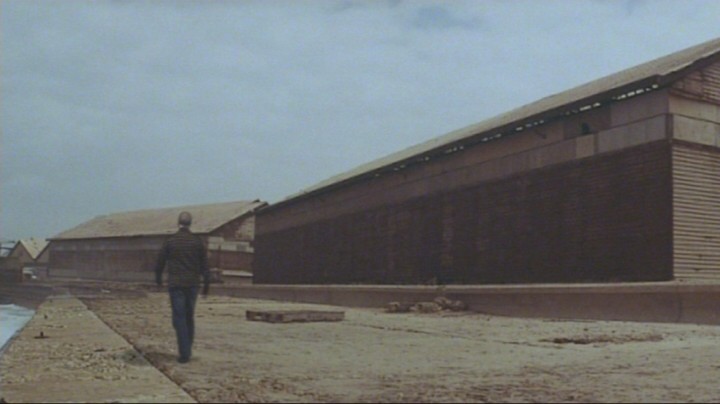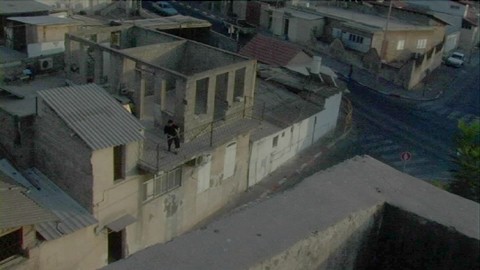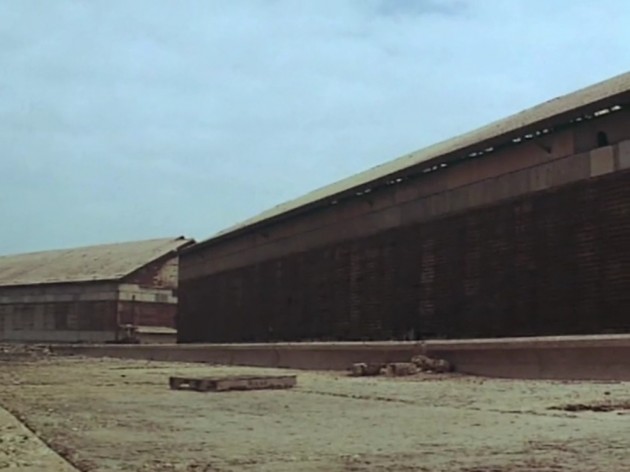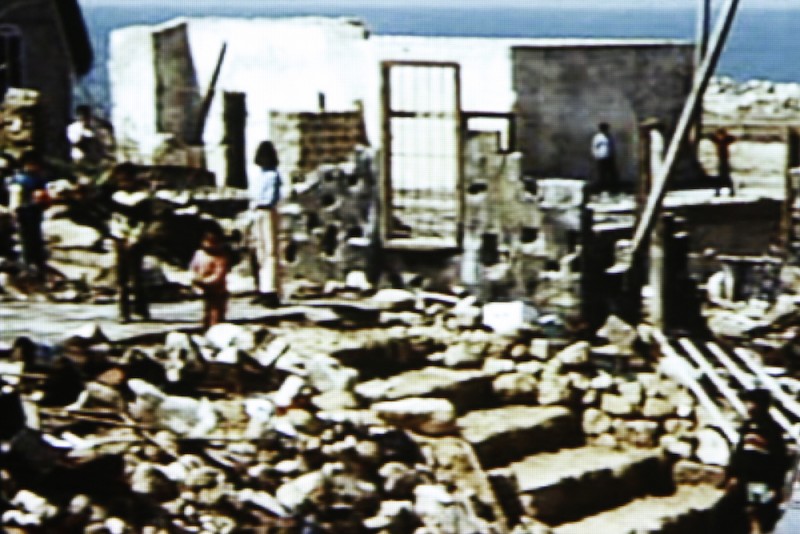October 2016
Review
ENG––FRA
The Circulation of Palestinian Images
In many ways, each of these films seems to present images that are frozen or suspended in a time that is lost or is in the process of being rediscovered. Furthermore, these films are driven by a tension between stillness and openness towards an indeterminate future.

Who knows if the balconies we see are partially destroyed or partially built? Are the shuttered houses abandoned or protecting against the heat of the afternoon? There a door ajar, here a man pulls his suitcase. These solitary images reconstitute political histories of exile and forced departures. In fact, the homes in Balconies are not empty and people are not absent. They are either evicted or outside, and these houses are imbued with their history and their forced displacement. To rethink the non-presence of Palestinians beyond absence, which is then construed as definitive, is to defy the colonial “absentee property laws” that have justified the Israeli appropriation of Palestinian lands and homes at the time of the creation of the State of Israel in 1948. These laws are repurposed today in the logics of gentrification, as illustrated in Port of Memory. The temporality of these films is thus not fixed; instead, these houses and its Palestinian inhabitants are settled in the thickness of time. The long takes in Port of Memory and The Roof evoke the resistance of Palestinians who remain in their homes despite attempts to dislodge them. The stagnation of images and architecture is an expression of sumud, that is to say, Palestinian steadfastness, perseverance and continuity in the face of ethnic cleansing.

And so, it is an ethical obligation to situate these supposedly still images within a historical movement that has brought them into the materiality of film, and in a more general manner, into an economy of Palestinian cinema that must constantly negotiate the politics of its artistic discourses. As the title of Port of Memory suggests, these films are nodes in a network of circulating memory, but they also represent these concrete infrastructures such as the port of Jaffa, where Palestinians driven out by the violence of colonization have embarked on their exile. Finally, these films travel to other ports, such as film festivals, which are privileged platforms for the circulation and the negotiation of Palestinian poetic and politics.

In the same manner, the conflicting temporality of Visit Iraq – where the travel agency, site of planning, is maintained in an abandoned state – suggests experiences of voyage and exile. Why does a Palestinian director who holds an Israeli passport and is studying in Germany, document an Iraqi travel agency located in Geneva? Can we imagine a pan-Arabic solidarity conditioned by the anti-colonial discourse of the 1950s and exacerbated by the US invasion contemporary to the filming, which also parallels the continued occupation of Palestine largely funded indirectly by the US? Similarly, could the fact that the abandoned travel agency, a symbol of the interruption of trade with Iraq at war, is located in the headquarters of the UN, Geneva, testify to the inability of the Organization to ensure the peace that is at the heart of its mandate? And this at the very moment when the Palestinian uprisings of the second Intifada struggle against the continuing Israeli occupation, made possible by the 1947 partition sanctioned by the UN itself. Such a contextualization goes unexplained in the film and might exceed the intentions of its author. Nonetheless, it provides some elements to understand the geopolitical depth of the contradictory temporality of the agency. This context also reveals the importance of reflecting on the possibilities and impossibilities of travel. In contrast to Palestinians in the West Bank and Gaza, the director can cross the Israeli borders without special request because he holds an Israeli passport; however, the scene in The Roof where he reconnects with an old friend based in Beirut through the phone, reminds us that he is legally prohibited from visiting most Arab countries because of his imposed nationality. Thus, Iraq is one such country that the director can only imagine through the windows of an abandoned office.

It has often been remarked that displacement is at the heart of Kamal Aljafari’s work, much like the violence of forced displacement is at the heart of Palestinian history since the beginning of the Zionist settler-colonial movement at the start of the twentieth century. Displacement has governed the production of a political and militant Palestinian cinema in the late 1960s, a refugee cinema in exile, fighting for the liberation of Palestine and pronouncing a future return, which thrived until the refugees’ canvas tents turned into concrete camps and the temporary became permanent. Similarly, if several forms of displacement are present in the work of Aljafari, one should also take into equal account the importance of the diverse modes of circulation of Palestinian imagery, including the movement of return, also invoked in these films. Recollection repopulates the streets filmed by Israelis with Palestinian presence by reworking and recirculating Israeli film material without their authors’ consent. The return of Palestinians to historic Palestine (which precedes the first stage of colonization that gave this land the contemporary name of Israel) is here performed by a negation of Israel’s ownership of these films, which are the product of the dispossession of Palestinians’ land. If we want to keep open the possibility of a Palestinian future, displacement and return must thus be seen as two sides of the same coin.
Poetic considerations therefore have a very material reality. The images with which Aljafari plays in Recollection belong to the economy of the occupation. These images have participated in the construction of an Israeli heritage oblivious of Palestinians and an Israeli film industry financed by a colonial power. At the same time, the movement of dispossessing Palestinians through images fits into the contemporary balance of power between the European funds that invest in Palestinian films and Palestinian artists themselves at the moment of producing their own history. Peter Limbrick reports on the relationship between Aljafari and the German funding in his discussion of The Roof. He noted that one of the co-producers, from the national German television station ZDF, set conditions with which the director was in disagreement. Following this process of artistic dispossession in which the sponsor was in a position to impose a certain narrative of political history, Aljafari undertook to repossess his images and finish the film according to his own understanding, an action that the ZDF ruled illegal1 As highlighted again by Limbrick, this confrontation, at first anecdotal, speaks volumes on the possibilities and permissions that Palestinians have to make visible the violent history of colonization.

What kind of Palestinian image is thus allowed to circulate? As suggested above, festivals, but also contemporary art centers and galleries are among the places where Palestinian images in general and those of Aljafari in our case, circulate more easily (which is not to say without any constraint, as we have just seen). The articulation of the political through the poetic helps facilitate this movement, because the nuanced and subtle work on the image can be understood by funding bodies as a process of universalizing political issues. The use of poetry can be seen as an aesthetic rather than geopolitical commitment susceptible to attract a large and educated audience. On the other hand, to understand the poetry of these images is also to disentangle them, and to retrace the highly political path that they draw. It is again the ethical obligation to assign ourselves to a politicized archeology of these images which demands that we participate in circulating them as much as possible. And this not only to popularize certain representations, but also for building an economy of Palestinian images. We must first understand this economy in a symbolic sense, which is to encourage the flow of these images so they take on a greater role in the international narratives of Palestine. From a material point of view, it means creating conditions that will allow the possibility to produce more Palestinian images and more images of Palestine. This reflection comes in a contemporary context hostile to Palestinian images, and resistant to criticism of the Palestinian dispossession. Thus the violent opposition to the boycott of Israeli institutions initiated by the Palestinian BDS (Boycott, Divestment, Sanctions) highlights a misunderstanding of (or disinterest in) the economic ramifications of the occupation and its impact on even the possibility for Palestinians to produce their own history. [BDS] To conclude this reflection on a poetic and political note, the boycott advocated by BDS performs an operation similar to the one at work in Recollection: a refusal to support an economy of the occupation, which results in the circulation of a Palestinian narrative.
Translated from French by Donato Totaro and Viviane Saglier
Note
NOTES
1 Peter Limbrick, “Contested Spaces: Kamal Aljafari’s Transnational Palestinian Films,” in A Companion to German Cinema, Terri Ginsberg and Andrea Mensch (dirs.), Malden, Wiley-Blackwell, 2012, p. 218-248.
FRENCH
Les films de Kamal Aljafari se répondent les uns aux autres et rejouent l’histoire de la Palestine spoliée et en processus de dépossession. Visit Iraq (2003) recueille les rumeurs et fascinations qui circulent autour du bureau abandonné de l’agence de voyage Iraqi Airways à Genève, dont le loyer est payé chaque mois bien qu’il soit inoccupé depuis plus de dix ans. Cet espace fantomatique pose les bases des paysages, cette fois bien palestiniens, décrits dans les films suivants. The Roof (2006) convoque ainsi la possibilité de penser aux ruines comme étant à la fois l’interruption, la confiscation, et la possibilité du futur, alors que le film construit sa narration autour du bâtiment où vit la famille du réalisateur. Balconies (2007) compose des diptyques autour des balcons qui, comme le deuxième étage de la maison de The Roof, demeurent inachevés. Port of Memory (2009) s’attarde à nouveau sur la maison de la famille du réalisateur alors que celle-ci s’apprête à subir une expulsion sous le régime des lois coloniales israéliennes. Les images du tournage d’un film israélien figuré dans Port of Memory se retrouvent métaphoriquement dans Recollection (2015), qui retravaille la matière de films populaires israéliens pour répondre à leur effacement des narratives urbaines palestiniennes en réintégrant les Palestiniens dans leur paysage.
Par bien des côtés, chacun de ces films semble présenter des images figées ou suspendues dans une temporalité perdue ou en processus d’être recouverte. Plus encore, ces films sont animés par une tension entre l’immobilité et l’ouverture vers un futur indéterminé.

Qui sait si les balcons sont partiellement détruits ou partiellement construits ? Les maisons aux volets fermés sont-elles désertées ou se protègent-elle contre la chaleur de l’après-midi ? Là une porte est entrouverte, ici un homme tire sa valise. Ces images solitaires reconstituent des histoires politiques, de fuites, et de départs forcés. De fait, les maisons de Balconies ne sont pas vides et ses habitants ne sont pas absents. Ils sont soit expulsés, soit à l’extérieur, et ces maisons restent imprégnées de leur histoire et de leurs déplacements forcés. Repenser ici la non-présence des Palestiniens par-delà la temporalité fixe d’une absence temporaire qui deviendrait par là-même définitive, c’est défier les lois coloniales sur « les biens des absents » qui ont justifié la réappropriation israélienne des terres et des maisons palestiniennes au moment de la création de l’État d’Israël en 1948, et qui sont mises en œuvre encore aujourd’hui comme l’illustre Port of Memory. La temporalité de ces films n’est ainsi pas fixe ; au contraire, ces maisons et ses habitants palestiniens s’installent dans l’épaisseur du temps. Les longs plans continus de Port of Memory et The Roof évoquent la résistance des Palestiniens qui demeurent dans leurs habitations malgré les tentatives de les en déloger. Cette stagnation, des images, de l’architecture, est une expression de sumud, de la résilience palestinienne à l’épreuve du nettoyage ethnique, et de la persévérance et continuité comme futur.


Ainsi, voir ces images supposément fixes comme étant tributaires d’une circulation historique qui les a portées dans la matière du film, et d’une manière plus générale, dans une économie du cinéma palestinien qui doit sans cesse négocier la part politique de ses discours artistiques, devient une obligation éthique. Comme le titre de Port of Memory le suggère, ces films sont des nœuds dans des réseaux de circulation de la mémoire, mais ils représentent aussi ces infrastructures concrètes, comme le port de Jaffa, où les Palestiniens chassés par la violence de la colonisation ont embarqué dans leur exil. Enfin, ces films voyagent dans d’autres ports, les festivals de cinéma, lieux privilégiés de circulation pour la négociation du poétique et du politique palestiniens.
De la même manière, les temporalités contradictoires de Visit Iraq, où l’agence de voyage, lieu de planification, est laissée dans un abandon entretenu, laissent aussi transparaître des récits de voyage et d’exil. Pourquoi un réalisateur palestinien détenteur d’un passeport israélien et alors étudiant en Allemagne documente-t-il une agence de voyage irakienne située à Genève ? Peut-on y voir un élan de solidarité panarabe héritée des discours anticoloniaux des années 1950 et exacerbée par l’invasion américaine, contemporaine au tournage, qui évoque aussi l’occupation continue de la Palestine largement financée indirectement par les Etats-Unis ? De même, le fait que l’agence de voyage abandonnée, symbole de l’interruption des échanges avec l’Irak en guerre, soit située à Genève, siège de l’ONU, pourrait-elle témoigner de l’incapacité de l’Organisation à garantir cette paix qui est au cœur de son mandat ? Et ceci au moment-même où les soulèvements palestiniens de la deuxième Intifada luttent contre la poursuite de l’occupation israélienne, rendue possible par la partition de 1947 sanctionnée par l’ONU elle-même. Ce contexte, inexpliqué dans le film, donne toute sa profondeur géopolitique à l’exploration de la temporalité contradictoire de l’agence. Ce qu’il révèle aussi est l’importance d’une réflexion sur les possibilités et les impossibilités de voyage. Alors que, contrairement aux Palestiniens de la Cisjordanie et de Gaza, le réalisateur peut sortir des frontières israéliennes sans demande spéciale parce qu’il est détenteur d’un passeport israélien, une scène de The Roof où il recontacte un vieil ami établi à Beyrouth nous rappelle que la plupart des pays arabes lui sont légalement interdits à cause de sa nationalité imposée. Ainsi, l’Irak est l’un de ces pays que le réalisateur ne peut qu’imaginer à travers les vitrines d’une agence abandonnée.

On a souvent fait remarquer que le déplacement était au cœur du travail de Kamal Aljafari, comme la violence du déplacement forcé est au cœur de l’histoire palestinienne depuis le début du mouvement de colonisation sioniste au début du vingtième siècle. Le déplacement a présidé à la production d’un cinéma politique et militant palestinien dans la fin des années 1960, un cinéma réfugié, en exil, qui luttait pour la libération de la Palestine et prônait le futur d’un retour, avant que les tentes en toiles ne s’érigent en camps de béton et que le temporaire ne devienne permanent. De même, si plusieurs formes de déplacement sont bien présentes dans le travail d’Aljafari, prendre en compte la diversité des modes de circulation des images palestiniennes, notamment le mouvement du retour, aussi évoqué dans ces films, est tout aussi important. Recollection repeuple les rues des films israéliens par la présence palestinienne en utilisant des films retravaillés et remis en circulation sans le consentement de ses auteurs. Le retour des Palestiniens en Palestine historique (celle qui précède la première étape de colonisation qui a donné à ces terres le nom contemporain d’Israël) est ici effectué par une négation de la propriété israélienne de ces films, qui sont le produit de la dépossession des terres palestiniennes. Déplacement et retour sont ainsi les deux facettes d’une même pièce, si l’on veut garder ouverte la possibilité d’un futur palestinien.
Les considérations poétiques ont donc une réalité bien matérielle. Les images avec lesquelles joue Aljafari dans Recollection appartiennent à une économie de l’occupation, et ces images ont participé à la construction d’un patrimoine israélien ainsi qu’à celle d’une industrie israélienne du cinéma financés par un pouvoir colonial et spoliateur. De même, ce mouvement de dépossession des images des Palestiniens s’inscrit dans le rapport de force contemporain entre les fonds européens qui investissent dans les films palestiniens et les artistes palestiniens eux-mêmes au moment de produire leur histoire. Peter Limbrick fait état de la relation entre Aljafari et ses financements allemands dans l’élaboration de The Roof. Il rapporte que l’un des coproducteurs, la chaîne nationale de télévision allemande ZDF, a posé des conditions avec lesquelles le réalisateur était en désaccord. Suite à ce procédé de dépossession artistique dans lequel le sponsor est en position d’imposer une certaine narration d’une histoire politique, Aljafari a entrepris de reprendre possession de ses images afin de finir le film selon sa propre compréhension, une action que la ZDF a jugé illégale1. Comme le souligne à nouveau Limbrick, cette confrontation de premier abord anecdotique en dit long sur les possibilités et les permissions qu’ont les Palestiniens de rendre visible une histoire violente de colonisation.

Quel type d’image palestinienne est donc autorisé à circuler ? Comme suggéré plus haut, les festivals, mais aussi les centres d’art contemporain et les galeries sont parmi les lieux dans lesquels les images palestiniennes en général, et celles d’Aljafari dans notre cas, circulent le plus aisément (ce qui ne veut pas dire sans aucune contrainte, comme nous venons de voir). L’articulation du politique par le poétique contribue à faciliter cette circulation, parce que le travail nuancé et subtil sur l’image peut être compris par les responsables du financement comme un processus d’universalisation des questions politiques, et comme un engagement esthétique plus que géopolitique qui provoque une forte attraction émotionnelle capable de plaire à un public large et éduqué. En revanche, comprendre la poésie de ces images revient aussi à les désenfouir, et à retracer le parcours hautement politique qu’elles dessinent. C’est aussi l’obligation éthique de s’attacher à une archéologie politisée de ces images qui demande que nous participions à les faire circuler autant que possible. Et ceci non seulement pour populariser certaines représentations, mais aussi pour construire une économie palestinienne des images. On peut d’abord comprendre cette économie au sens symbolique du terme, celui d’encourager le flux de ces images afin qu’elles prennent une plus grande place dans les récits internationaux sur la Palestine. D’un point de vue matériel, il s’agit de créer les conditions qui vont permettre la possibilité de produire plus d’images palestiniennes et de la Palestine. Cette réflexion s’inscrit dans un contexte contemporain hostile aux images palestiniennes, et réfractaire aux critiques de la dépossession des Palestiniens. Ainsi, l’opposition violente au boycott des institutions israéliennes initié par le mouvement palestinien BDS (Boycott, Désinvestissement, Sanctions rend compte d’une incompréhension (ou d’un désintérêt) des ramifications économiques de l’occupation et de leur impact dans la possibilité même qu’ont les Palestiniens de produire leur histoire. Pour conclure cette réflexion sur une note poétique et politique, le boycott prôné par BDS effectue une opération semblable à celle qui est à l’œuvre dans Recollection : un refus de soutenir une économie de l’occupation qui se traduit par la remise en circulation d’une histoire palestinienne.
Viviane Saglier est membre du collectif Regards palestiniens.

